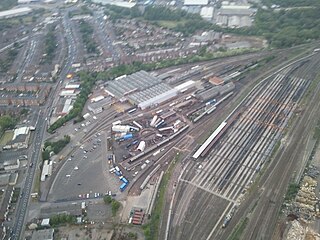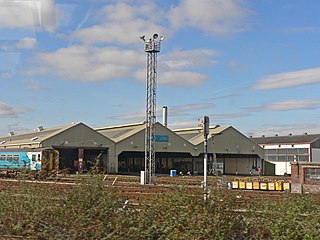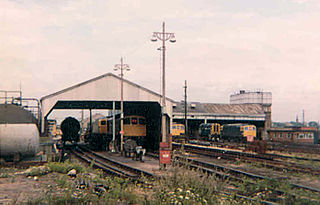
The motive power depot (MPD) or locomotive depot, or traction maintenance depot (TMD), is the place where locomotives are usually housed, repaired and maintained when not being used. They were originally known as "running sheds", "engine sheds" or, for short, just sheds. Facilities are provided for refuelling and replenishing water, lubricating oil and grease and, for steam engines, disposal of the ash. There are often workshops for day to day repairs and maintenance, although locomotive building and major overhauls are usually carried out in the locomotive works.

St Blazey engine shed is located in Par, Cornwall, United Kingdom, although it is named after the adjacent village of St Blazey. It was built in 1874 as the headquarters of the Cornwall Minerals Railway but for many years was a depot of the Great Western Railway. The current depot operator is DB Cargo and the depot TOPS code is BZ.

Old Oak Common TMD was a traction maintenance depot located west of London Paddington, in Old Oak Common. The depot was the main facility for the storage and servicing of locomotives and multiple-units from Paddington. The depot codes were OC for the diesel depot and OO for the carriage shed. In steam days the shed code was 81A.

Laira T&RSMD is a railway traction and rolling stock maintenance depot situated in Plymouth, Devon, England. The depot is operated by Great Western Railway and is mainly concerned with the overhaul and daily servicing of their fleet of High Speed Trains and also the DMUs used on local services. The depot code "LA" is used to identify rolling stock based there.

Immingham engine shed, also known as Immingham depot, or more recently as Immingham TMD and always locally as Loco is a railway maintenance depot located on the Immingham Dock estate, in North East Lincolnshire, England. The depot code is IM.

Tyseley TMD is a railway traction maintenance depot situated in Tyseley, Birmingham, England.

Cardiff Canton TMD is a diesel locomotive traction maintenance depot in Cardiff, Wales. Its depot code is CF. It is operated by Transport for Wales. The depot is used by Transport for Wales fleet and some Cross Country Class 170s.

Gateshead TMD was a railway traction maintenance depot situated in Gateshead, England. The depot code was 52A during the steam era and GD later on.

Penzance TMD, also known as Long Rock TMD, is a railway traction maintenance depot situated in the village of Long Rock east of Penzance, Cornwall, England, and is the most westerly and southerly rail depot in the country. The depot operator is Great Western Railway. The depot code is PZ.

Landore TMD is a railway traction maintenance depot situated in Landore, a district of Swansea, Wales. There was a shed for steam locomotives here, and in 1963 British Rail opened a purpose-build diesel depot. Under privatisation the depot was operated by Great Western Railway to service its fleet of InterCity 125s until it closed in December 2018. The site reopened in September 2019 as a rolling stock refurbishment centre.

Thornaby TMD was a railway traction maintenance depot situated in Thornaby, England, latterly operated by DB Schenker. The depot was situated to the east of Thornaby, on the northern side of the line to Middlesbrough.

Hither Green (London) Traction Maintenance Depot or Hither Green (London) TMD is a railway depot used for the maintenance and servicing of freight trains adjacent to the Hither Green marshalling yard. The depot is a hub for moving freight around southeast England. Hither Green TMD is owned and operated by DBS. The official depot code is HG. In steam days the shed code was 73C.

Exeter Traction Maintenance Depot is a railway Traction Maintenance Depot situated in Exeter, Devon, United Kingdom and is next to the city's main St Davids station. The depot is operated by Great Western Railway and has an allocation of diesel multiple units.

Stratford TMD was a traction maintenance depot located in Stratford, London, England close to the Great Eastern Main Line. It was located just west of Stratford station, on a site now occupied by Stratford International station. The depot was at one time the biggest on the London and North Eastern Railway with locomotives covering duties from express services to freight workings in London's docks.
There were a number of engine sheds and railway works located in York. The large York North engine shed became the National Railway Museum in 1975.

Stewarts Lane is a large railway-servicing facility in Battersea in London, England, founded by the London Chatham and Dover Railway (LCDR) in 1862, to serve London Victoria railway station. It is sited in the midst of a maze of railway lines between 'Factory Junction' and 'Stewarts Lane Junction', adjacent to the site of the former Longhedge Railway Works and the Stewarts Lane Chord formerly used by Eurostar trains from the Kent freight lines to Waterloo International station. Prior to 1962 it was one of the largest motive power depots in the UK. Following the end of steam traction in the early 1960s it was converted into a traction maintenance depot which is currently operated by Govia Thameslink Railway.

Botanic Gardens TMD was an engine shed in Kingston upon Hull in Yorkshire, England. As one of the principal engine sheds in the Hull area, Botanic Gardens was the one closest to the main Hull Paragon station and its locomotives were responsible for working passenger services in the area. This entry also covers the engine sheds in the Paragon area that preceded Botanic Gardens.
Alexandra Dock engine shed (Hull) was an engine shed located in Kingston upon Hull, Yorkshire, England and was opened by the Hull Barnsley and West Riding Junction Railway and Dock Company (HBR) in July 1885. The shed was closed by British Railways in October 1963 although the site remained in use as a stabling point and signing on point for drivers until rail traffic ceased to the dock in 1982.

















